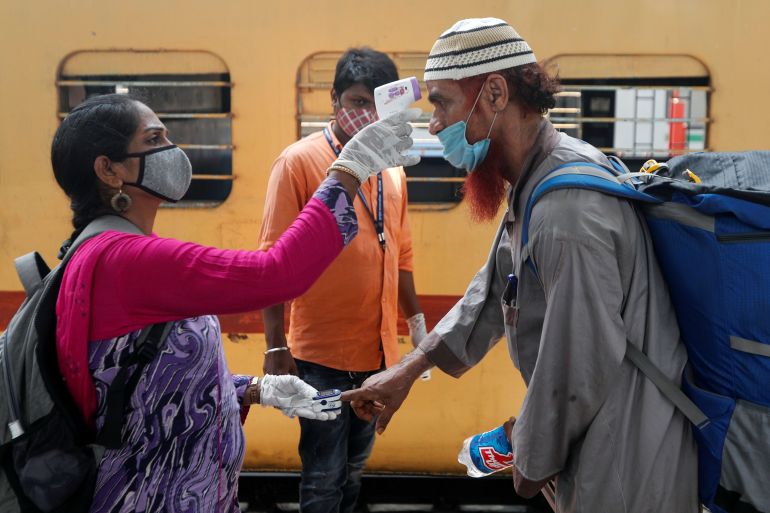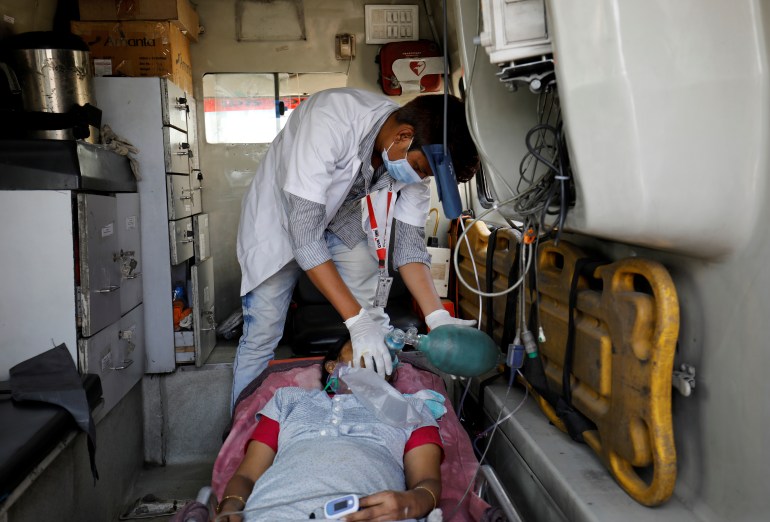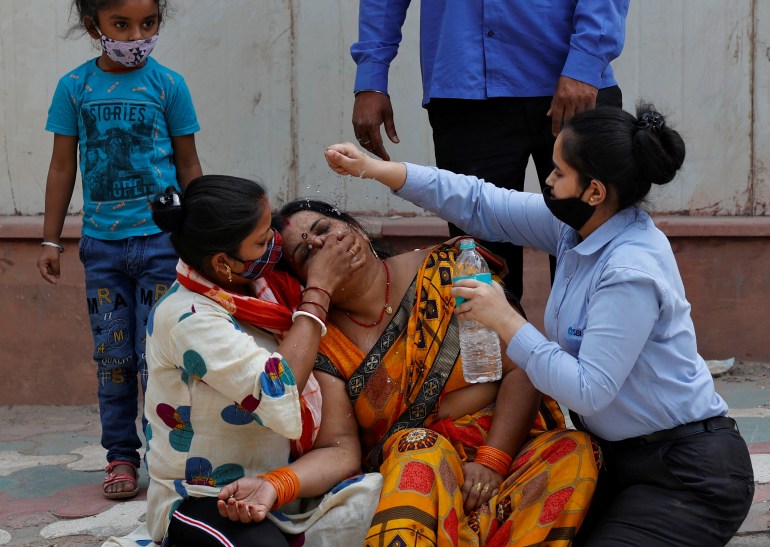Oxygen shortage in India’s Maharashtra as COVID cases soar
Maharashtra state grapples with oxygen and hospital bed shortages as COVID-19 cases spread to remote corners.

When COVID-19 struck Karamsingh Pawar, a tribal activist from Nandurbar district in northwestern Maharashtra, it took him 48 hours to get a hospital bed with oxygen support.
After the 55-year-old was admitted into the government-run COVID-19 centre, he had to spend half a day in the corridor before being shifted to a bed on April 11.
Keep reading
list of 4 itemsIndia reports another record daily rise in COVID infections
India: migrant workers leave cities as COVID measures bite
COVID ‘super-spreader’ erupts as devotees throng Indian festival
By then, his oxygen saturation was dangerously low and he succumbed the next day. “He was severely breathless by the time he was put on oxygen support,” Pawar’s son-in-law Prabhakar Thakare told Al Jazeera over the phone.
As Maharashtra, India’s richest state, grapples with ferociously rising COVID-19 cases, patients such as Pawar are struggling to find hospital beds and oxygen support. The state’s daily oxygen usage has touched 1,500 metric tonnes, according to Health Minister Rajesh Tope.
This is much more than its daily production of 1,250 tonnes. While other states are contributing to plug the shortfall, transportation by road takes time. Maharashtra Chief Minister Uddhav Thackeray has now requested Prime Minister Narendra Modi to deploy the National Disaster Management Authority to airlift oxygen for rapid movement.
10,000 ‘active cases’
Nandurbar, 450km (220 miles) away from financial capital Mumbai, is a tribal-dominated and acute malnutrition-hit district with poor healthcare infrastructure and difficult hilly terrain. As the virus spreads rapidly in such remote areas, Maharashtra stares at a greater challenge in arresting the continuing second wave of the pandemic.
“In the first wave, our active cases hovered around 300 to 500,” said Dr Nitin Bodke, district health officer of Nandurbar. “This time, the active cases have shot up to 10,000.”
The district currently has about 1,000 hospital beds for COVID-19 patients, including 400 with oxygen and intensive care support. To tackle the shortage, the district is set to open a 21-coach train modified into an isolation centre for victims.
The train will add 336 beds to the pool. Last year, more than 300 coaches were modified by Indian Railways and kept on standby. “Nandurbar was the first district to requisition the coaches,” said Sumit Thakur, chief public relations officer of Western Railway.

Maharashtra has recorded more than 3.7 million cases and 59,550 fatalities so far. It currently accounts for 40 percent of India’s total active cases. On Friday, the state reported 63,729 new infections. The highest surge has been recorded in Mumbai.
Other parts of eastern and western Maharashtra are also recording a high number of infections leaving patients to traverse hundreds of kilometres from one district to another in search of oxygen-capable hospital beds.
In Nanded district, a drought-prone region in southeastern Maharashtra, an 85-year-old had to travel 400km (250 miles) in an ambulance till she found an oxygen bed. Shalini Wadalkar succumbed on April 13, three days after hospitalisation.
“We went to four hospitals in Nanded, including one government hospital but none of them had an oxygen bed,” said Wadalkar’s nephew Vishal Dahale. From Nanded, they drove her to the neighbouring Yavatmal district about 200km (90 miles) away.
None of the hospitals had a vacant bed there, either. By then, they got a call from a private hospital in Nanded about a bed vacancy and immediately rushed back. “I had never been through so much mental agony. I can’t even imagine what my aunt was going through,” said Dahale.
‘Break the chain’
Experts say reducing the number of infections is the only way to salvage Maharashtra’s grim situation. On April 14, the state announced new restrictions until May 1. All establishments, public places and activities were shut down, barring essential services. Public transport was allowed to function.
“I certainly hope that these fresh sets of restrictions will break the chain of infection,” said Dr Om Shrivastav, an infectious disease specialist in a private hospital in Mumbai and member of Maharashtra’s COVID-19 taskforce.
In Mumbai, where the daily cases are now averaging 9,300, the civic body has implemented innovative ways to improve bed availability. Two five-star hotels were designated as “step-down” facilities for patients who no longer need emergency medical care and are on their way to recovery. More hotels will be requisitioned in the coming days for the transfer of patients.
In the continuing second wave, Mumbai has seen a jump in infections among the upper middle-class population. Owing to this trend, the demand for private hospital beds has risen. The shortfall of beds, mainly oxygen and intensive care unit ones, is also arising from the private sector.
On Saturday, 98 percent of Mumbai’s 2,711 ICU beds were occupied. In a rare step, the city’s Commissioner Iqbal Chahal ordered a private hospital to allot more than 75 percent of its beds for COVID-19 patients, and more may be asked to follow suit.
Maharashtra remains the top state in terms of vaccination with more than 10 million doses administered so far. But it hit a major roadblock recently with a shortage of both vaccines it is offering – India’s homegrown Covaxin by Bharat Biotech and AstraZeneca’s Covishield, which are being mass-produced by the Serum Institute of India.
Even as the vaccination drive has now resumed, health experts say the numbers are just a drop in the ocean for a state with a population of more than 120 million.
“India’s vaccination rate is overall low as compared to other countries, considering the large population,” said Soumitra Ghosh, assistant professor at the Centre for Health Policy, Planning and Management, Tata Institute of Social Sciences, Mumbai.
India has administered 119 million doses to date. In comparison, the United States has given about 200 million jabs. China has reportedly administered some 184 million shots.
“For large states like Maharashtra, the vaccination drive will need much more strengthening,” said Ghosh. “Not just vaccination, we also need to put the focus back on strict containment, isolation, testing and tracking of contacts. With the system overwhelmed with numbers, we currently lack this focus.”
